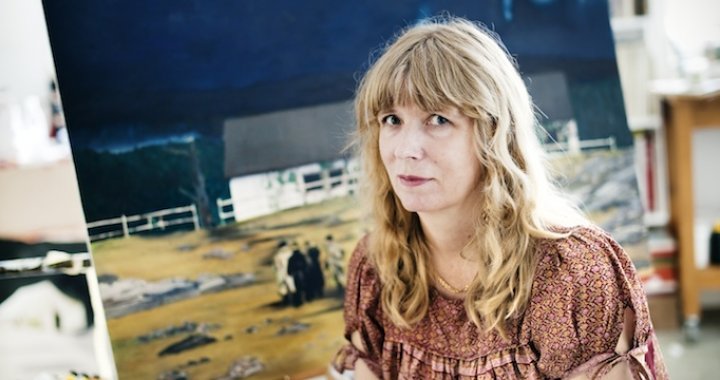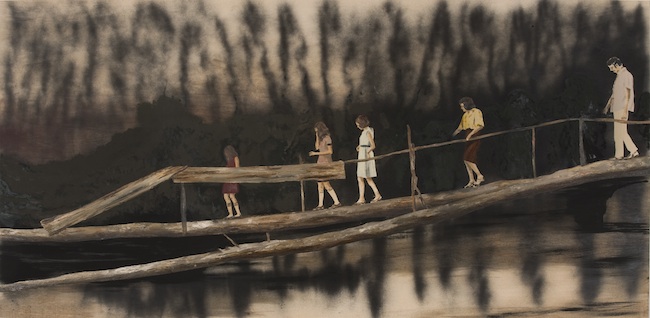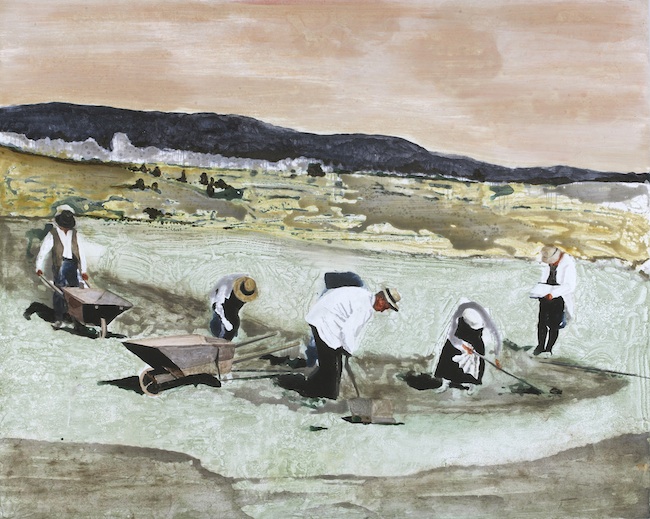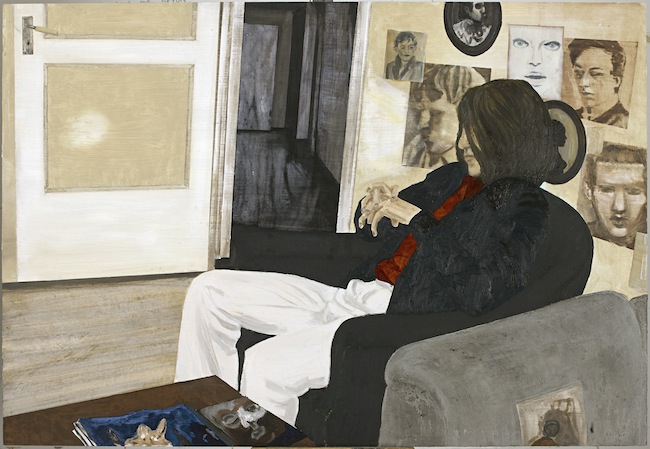
Mother’s day
Alida Ivanov
25/01/2013
One of the more renowned contemporary Swedish artists abroad Karin Mamma Andersson (b. 1962) is not only known for her large-scale paintings, but also for her smaller graphic pieces. Her motifs range between self-experienced events and dreamy landscapes, which are woven together into a pictorial story. The paintings are often made in series with motifs that return and change. She, however, is not afraid of breaking new ground.
In 1993 Karin Mamma Andersson graduated from the Royal Institute of Art, Stockholm, in 2006 she received 1st prize at Carnegie Art Awards and today she is represented by such art world authorities as the David Zwirner gallery (New York) and Stephen Friedman Gallery (London). But on January 25, 2013, an exhibition titled “Stargazer” is opening at Sven-Harry’s Art Museum in Stockholm, where Karin Mamma Andersson has taken on the role of a curator.
I have read that your nickname “Mamma” started off as a joke. Now you have had that name for 30 years, how has it shaped you?
The name has hung in there for about 20 years. It did start as a fun thing, but developed into something better, more beautiful, and more annoying than I ever could have imagined. After that revelation it was impossible for me to do without that name – Mamma.

Tick Tock. 2010. Mixed media on panel. 114,5 x 166,5 cm
A large part of your work consists of landscapes. What roles do the people and spaces have in your paintings? Has there been any significant change in the way you think about your work?
It’s very hard for me to see how it has changed, but one thing is certain: it does look differently today. I would say that both landscapes and people were, up until about 7 years ago, the subjects in my paintings. It created a story where something as small as a twig or a strain of hair could be equally important in substance as in picturesque qualities. My stories usually dealt with the issue of relationships.
Today the people and the landscape in my painting give me more of a reason to process materials and play with color combinations. The content now is more obscure and, in that way, more complex. The chamber play of relationships has become less important.
How has your work developed over the years?
The way I paint has changed simultaneously with life. With itty-bitty steps, day in and day out: like when winter changes into spring. Things happen every day and all of a sudden you’re standing there, in the sun eating an ice cream and the down jacket is hanging up in the attic.
How much of your work is autobiographical?
Almost all authors and artists get that question: if their work is autobiographical. Yes, what else would it be?
Even if it really isn’t about one’s own life, every story told comes from within and is a result of your self, at least on some level. It’s through your own experience that you interpret a situation, or another person.

Ramble On. 2011. Mixed media on panel. 111,5 x 228,5 cm
You illustrated a poetry book by Thomas Tidholm, do you often work from or with text in your art?
My work has probably never had a starting point in text. I do read poetry and literature, but not much and not often. It happens, that a text line might feel as if it were specifically written for a picture. I have been very interested in a few poets from the late 90’s. One of them would be the Swede Gustav Fröding. Titles like “Prins Alladin den store” (Prince Aladdin the great), “Grå dagar från förr (den kuvade klanen)” (Grey Days From The Past (The Subdued Clan)) have also become the names of paintings.
In the book, for my exhibition at Moderna Museet, they used some of Thomas Tidholm’s texts. I also asked Swedish playwright Lars Norén if he could write something. It resulted in a conversation between him and I that was taped and then edited into written form.
A year ago I had also asked Elfriede Jelinek to write the catalogue text for my exhibition “Dog Days” at Galleri Magnus Karlsson in Stockholm, which she did. I, on the other hand, use texts from encyclopedias as often as I use song lyrics. I find film and theater interesting too.
To decide a title can be a sensitive matter; the wrong one can signalize an incorrect message, and I don’t want to put words in someone’s mouth. A title should inveigh distress from afar and I think that the ones that are multifaceted are the best.
You take scenes that are well known to the beholder, and then you deconstruct them. How does this process look like?
Right now I’m working on a show that will open in London, in April. I started to work on it about a year ago. Not with the painting in itself, but that too. For me, the process starts by looking for the material that will work as a kind of inspiration. It can be anything: from historical books on castles in Austria to books on textile applications. This process has a lot to do with getting excited about entering a whole new world and a new state of mind.

Looters. 2010. Acrylic and oil on linen. 120 x 150 cm
Is it a conscious process?
The content exists in my hand, my eye, my sorrow, and in my experience, so to speak. I want to believe that I am in charge of it and that I am conscious of what I am doing. But when the work is in motion I have no idea where it will lead to, so I just go with the flow.
Why painting and not something else?
For a long time I thought it would be film that I would devote my life to. That was not what transpired. I’m a painter and I don’t feel that I’m even close to being finished with it. The technique one chooses doesn’t really matter; it’s more about feeling free and feeling comfortable in the method you chose to express yourself in.
When I started doing research on you I was surprised by the lack of a website. Why is it that you don’t have one?
I find it is stressful to have a cellphone and an email address. All these communicative techniques distract me. We get pinpointed and do it to others around us. If I don’t turn my cellphone off in the studio, I get about 10-15 calls during a working day. I read my emails once a day, at the most, and often late at night before I go to bed.
My galleries have websites that are updated often, which I think is enough.
Twitter and Facebook feel foreign to me. Sometimes I miss the time when people expressed themselves properly, wrote a letter with their own hand, and read it through one extra time before putting that letter in a postbox. I like writing postcards and getting cards from friends. These days it’s almost as silly and as strange as taking photos and then waiting for the film to develop. We have lost that. Everything is supposed to happen at once and nothing is allowed to abide and grow. You lose the longing and the hope, and maybe even the disappointment of photographs turning yellow and ugly.

Emo. 2010. Acrylic and oil on linen. 84 x 122 cm
I believe that it’s important for contemporary art to say something about the present. How do you make contemporary art if you overlook modern ways of communication?
You can’t do contemporary art. The one who tries is passé even before they start.
You work in various ways when it comes to art. Whatever it is that you do, most likely it is something involving the present, whether you want it or not. You eat in the present, watch movies, travel, dream and so on. What you express becomes a portrayal of the reality that you currently live in. The “present” happens by itself. Just as when you dream at night… it isn’t anything that you can influence.
What kind of art do you like? What is good art?
I like art. On Friday, January 25, a new exhibition will open here in Stockholm at Sven-Harry’s Art Museum. It’s called “Stargazer” and I curated it. It’s a mix of sculpture, installation, painting, photography and film. Represented there are Swedish artists, international artists, unknown, known, men, women, living and dead.